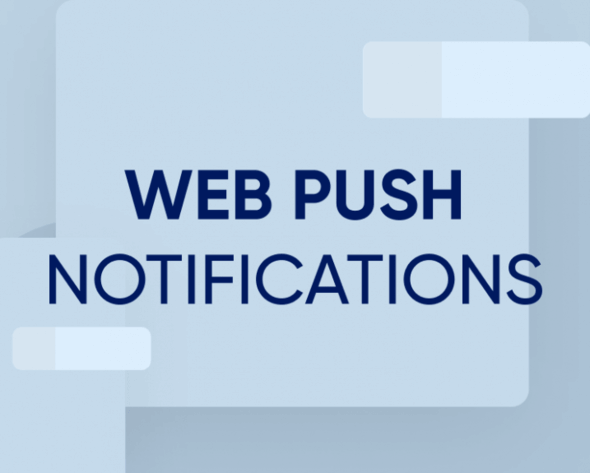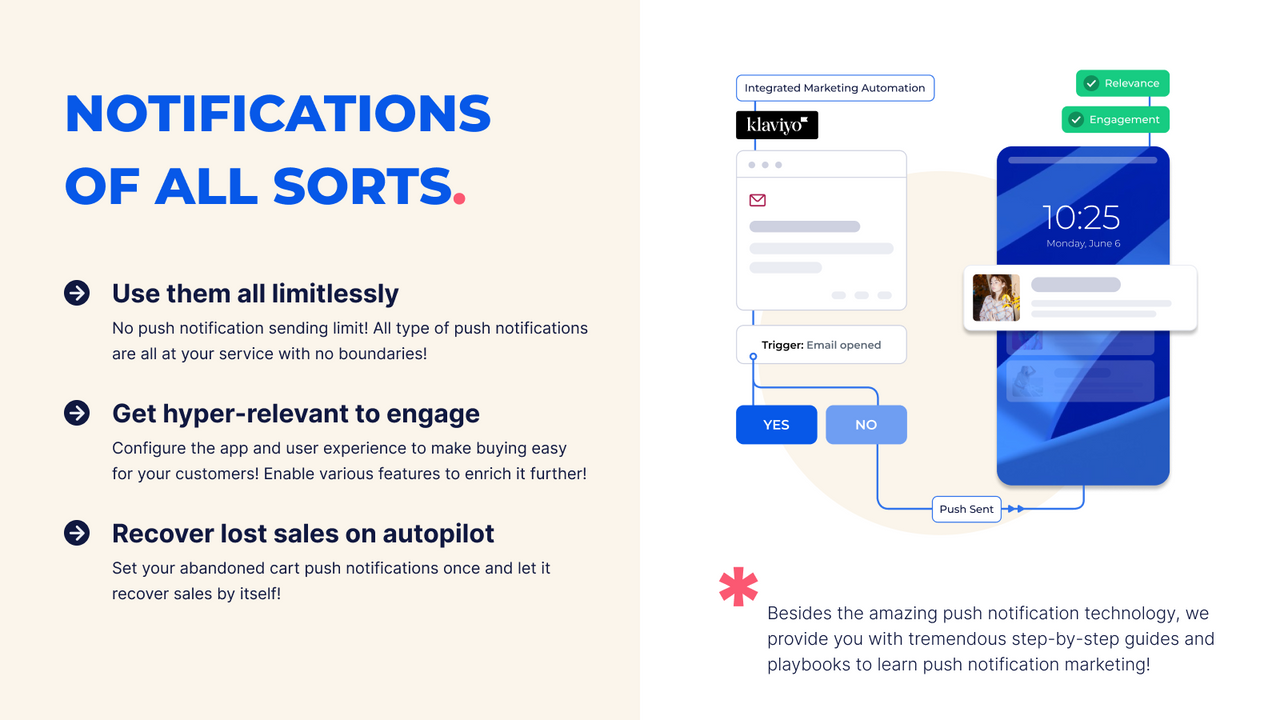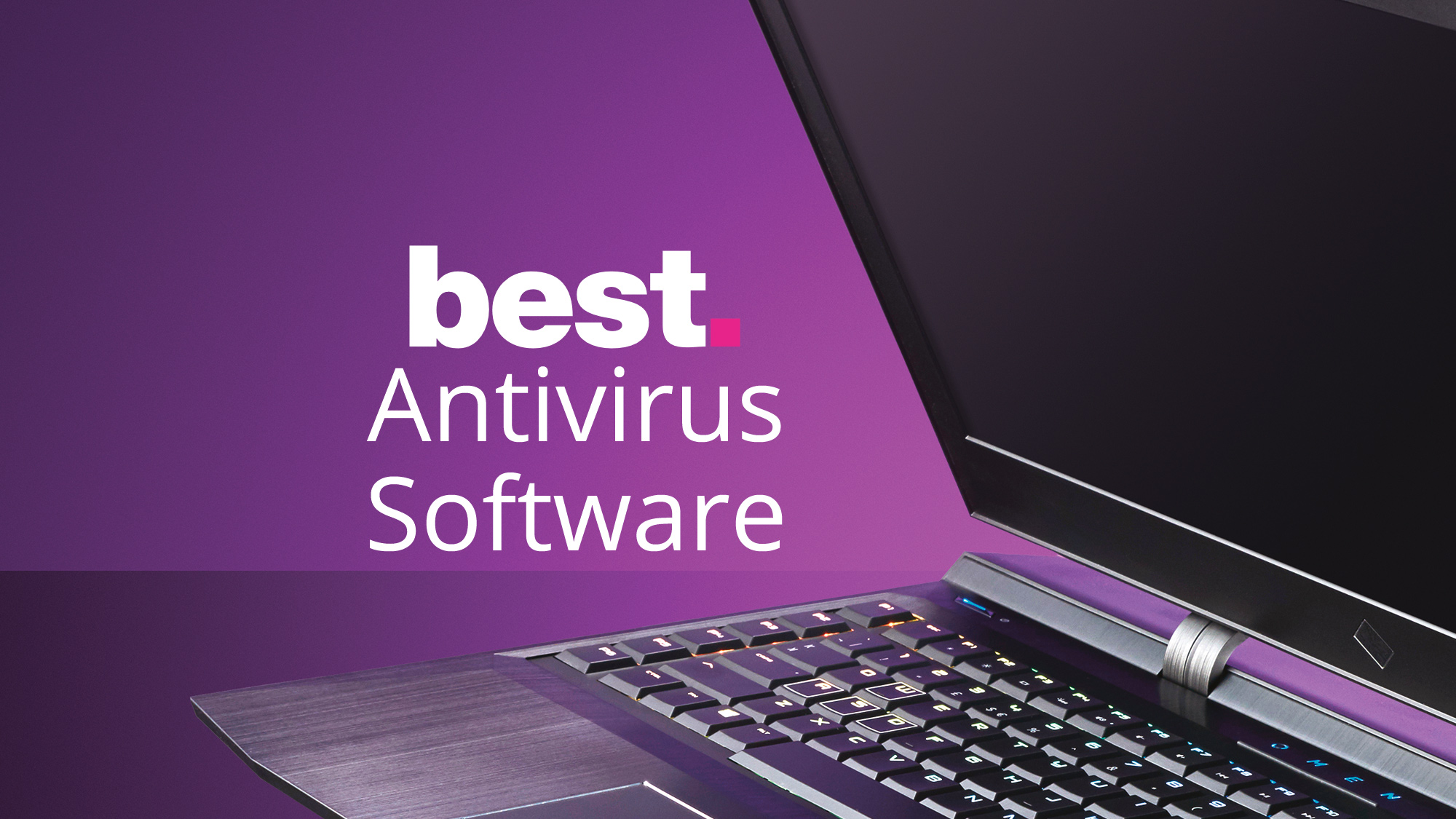Push notification marketing involves sending targeted messages to users’ devices to drive engagement and conversions. Effective strategies can boost customer interaction and sales.
When crafted well, push notifications can be a powerful tool for engaging with your audience. Let’s explore the ins and outs of push notification marketing and how you can leverage it to enhance your brand’s visibility and reach to drive meaningful results.
Whether you’re new to push notifications or looking to optimize your current strategy, this comprehensive guide will provide you with the knowledge and tips to succeed in this dynamic marketing channel. Read on to discover the best practices, creative tips, and implementation strategies for effective push notification marketing campaigns.

Credit: business.adobe.com
Introduction To Push Notifications
With the ever-evolving digital landscape, marketers are constantly searching for innovative ways to connect with their target audience. One such method that has gained immense popularity is push notification marketing. Push notifications provide a direct and impactful way to reach users across various devices and platforms. In this guide, we will dive into the world of push notifications, exploring what they are, their benefits, and how businesses can leverage their power to drive engagement and conversions.
What Are Push Notifications?
Push notifications are short, clickable alerts that are sent to users’ devices, including smartphones, tablets, and desktop computers. They are delivered through an application or website to users who have opted-in to receive these notifications. When a push notification is received, it appears as a pop-up on the user’s screen, displaying a concise message along with an optional image, icon, or call-to-action button.
These notifications serve as a direct communication channel between businesses and their audience, allowing them to instantly inform, update, and engage users. Whether it’s announcing a new product, sharing a promotional offer, or sending personalized content recommendations, push notifications enable marketers to deliver time-sensitive and relevant messages to their users.
Benefits Of Push Notifications
Implementing push notifications as part of your marketing strategy can yield several benefits:
| Benefits | Description |
|---|---|
| Increased Engagement | Push notifications offer a way to grab users’ attention instantly, leading to higher engagement rates compared to other marketing channels. |
| Personalized Communication | By leveraging user data, push notifications can be customized to deliver personalized messages and offers, creating a more tailored and relevant user experience. |
| Immediate Delivery | Push notifications are delivered in real-time, ensuring your messages reach users immediately, making them ideal for time-sensitive promotions or urgent updates. |
| Increased Traffic and Conversions | With the ability to drive users back to your website or app, push notifications can boost traffic and conversions by reminding users about abandoned carts, upcoming sales, or exclusive deals. |
| Improved Customer Retention | By staying top-of-mind with your audience through regular push notifications, you can nurture customer loyalty and increase customer retention rates. |
As you can see, push notifications offer an effective way to engage and communicate with your audience. In the following sections of this guide, we will explore the strategies, best practices, and tools needed to implement push notification campaigns successfully.
Crafting Compelling Push Notification Messages
Crafting compelling push notification messages is crucial for capturing the attention of your audience and driving engagement. To create effective push notifications, it’s essential to understand your audience, use strong calls-to-action, personalize messages, and leverage concepts of urgency and scarcity.
Understanding Your Audience
Before sending push notifications, understand your audience’s preferences, behavior, and interests to tailor your messages effectively.
Creating A Strong Call-to-action
Include a clear and enticing call-to-action that prompts users to take immediate action, such as “Shop Now” or “Learn More.”
Using Personalization
Personalize push notifications by addressing recipients by name or recommending products based on their previous interactions.
Leveraging Urgency And Scarcity
Create a sense of urgency by including time-limited offers or scarcity with messages like “Limited Stock Available” to drive conversions.
Segmentation And Targeting Strategies
When it comes to push notification marketing, segmentation and targeting strategies are critical to reaching the right audience with the right message. By effectively segmenting your user base and personalizing notifications, you can significantly improve engagement and conversion rates. Let’s explore the key segmentation and targeting strategies for push notification marketing.
Grouping Users Based On Behavior
Behavior-based segmentation involves grouping users based on their interactions with your app or website. By analyzing user behavior such as product views, purchases, or time spent on certain pages, you can create segments of users with similar interests or intentions. For instance, you can target users who have abandoned their carts or those who frequently engage with specific features. This allows for more relevant and timely notifications, increasing the likelihood of user response.
Segmenting Users By Location Or Demographics
Segmenting users based on location or demographics allows for targeted messaging tailored to specific regions or user attributes. For localized promotions, events, or store openings, targeting users based on their geographical location ensures that notifications are relevant to their current context. Additionally, segmenting by demographics such as age, gender, or interests enables personalized content that resonates with each user segment.
Personalizing Notifications For Each Segment
Personalization is key to driving engagement and conversions with push notifications. By tailoring the content of your notifications to each segment’s preferences and behavior, you can deliver more compelling and impactful messages. This can include personalized product recommendations, exclusive offers, or personalized content based on user preferences. By making each notification relevant and valuable to the recipient, you can nurture stronger connections with your audience.
Opt-in Strategies
Opt-in strategies are crucial for the success of push notification marketing. To effectively reach and engage your audience, it’s essential to implement the right tactics for encouraging users to opt-in. From prompt design to incentivizing users, and timing opt-in prompts, every aspect plays a significant role in determining the success of your push notification marketing efforts.
Effective Opt-in Prompt Design
When creating opt-in prompts for push notification marketing, it’s vital to focus on a visually appealing design that is clear, concise, and easy to understand. A well-designed prompt should clearly communicate the value users will receive by opting in while being non-intrusive and respectful of the user’s experience.
Incentivizing Users To Opt-in
Providing incentives to users can significantly increase opt-in rates. Offering exclusive deals, discounts, or access to premium content can motivate users to subscribe to push notifications. By clearly highlighting the benefits of opting in, users are more likely to engage with your messages and stay connected with your brand.
Timing Opt-in Prompts
The timing of opt-in prompts is crucial in capturing users’ attention without disrupting their experience. Timing prompts to appear after a user has engaged with your website or app can increase the likelihood of a positive response. Ensuring that prompts are not overly persistent or intrusive is essential in providing a positive user experience.
Automation And Triggered Notifications
In today’s fast-paced digital world, automation and triggered notifications hold immense power in reaching and engaging your audience effectively. By setting up automation workflows and leveraging user events for triggered notifications, businesses can drive user engagement, re-engage inactive users, and ultimately boost their conversions.
Setting Up Automation Workflows
Automated push notifications enable businesses to create personalized and timely messages that cater to the individual preferences and behaviors of their users. By setting up automation workflows, you can deliver targeted messages based on user actions, such as app installs, purchases, or interactions with specific content. These automated workflows streamline your marketing efforts and ensure that your messages reach the right users at the right time.
Leveraging User Events For Triggered Notifications
Leveraging user events for triggered notifications allows businesses to deliver real-time, relevant messages based on specific user actions. Whether it’s cart abandonment, product browsing, or reaching a milestone within an app, triggered notifications can be tailored to capitalize on these events and drive immediate engagement. By effectively utilizing user events, businesses can establish a deeper connection with their audience and keep them actively engaged with the brand.
Re-engaging Inactive Users
For businesses, re-engaging inactive users is a critical aspect of maintaining a strong and active user base. Through the use of automation and triggered notifications, you can implement win-back campaigns to reach out to users who have become disengaged. These targeted messages can entice inactive users with personalized offers, reminders, or relevant content, encouraging them to re-engage with your brand.

Credit: useinsider.com
A/b Testing Push Notifications
Discover the power of A/B testing push notifications in your marketing strategy with this comprehensive guide. Optimize message performance and engagement levels by testing different variations to drive better results. Master the art of push notification marketing and boost your brand’s visibility and conversions.
A/B testing push notifications is an essential step in optimizing your marketing strategy. By comparing different versions of your messages, you can identify what resonates best with your audience and improve your campaign’s performance. In this section, we will explore the process of A/B testing push notifications, including how to identify key metrics for testing, testing different messaging strategies, and analyzing and iterating based on results.
Identifying Key Metrics For Testing
When conducting A/B tests on push notifications, it’s crucial to identify the key metrics you want to measure. These metrics will help you determine the success of your tests and guide your decision-making process. Here are a few key metrics to consider:
- Open rate: Measure the percentage of users who open the notification.
- Click-through rate (CTR): Track the percentage of users who click on the notification.
- Conversion rate: Calculate the ratio of users who complete the desired action after receiving the notification.
- User engagement: Assess how users interact with your app or website after receiving the notification.
Testing Different Messaging Strategies
Now that you have identified your key metrics, it’s time to test different messaging strategies. A/B testing allows you to experiment with various elements of your push notifications, such as the content, tone, timing, and visuals. Here are a few strategies you can test:
- Personalization: Try customizing the notification with the recipient’s name or other relevant information.
- Call to action (CTA): Experiment with different CTAs to see which drives the highest engagement.
- Message length: Test shorter or longer notifications to gauge their impact on user response.
- Timing: Vary the time of day or day of the week when sending notifications to find the optimal timing.
Analyzing And Iterating Based On Results
Once you have executed your A/B tests and gathered the results, it’s crucial to analyze the data and iterate your push notification strategy accordingly. Consider the following steps:
- Compare performance: Compare the metrics of each variation to identify the most successful approach.
- Make informed decisions: Use the data to inform your future push notification strategies, focusing on the messaging strategies that yield the highest engagement and conversion rates.
- Iterate and optimize: Continuously test new variations and iterate on your messaging based on the insights gained from your A/B tests.
By regularly A/B testing your push notifications and analyzing the results, you can refine your messaging strategies, improve user engagement, and ultimately drive better results for your marketing campaigns. Remember to always stay data-driven and continue optimizing to stay ahead in the competitive world of push notification marketing.
Best Practices For Push Notification Timing
Push notifications have become an essential tool for marketers to engage with their audiences, delivering timely and relevant messages. However, to achieve the desired impact, it’s crucial to follow best practices for push notification timing. When messages are sent at the right frequency and timing, they can effectively capture your users’ attention and drive higher conversions. In this guide, we will explore the key considerations for timing your push notifications to maximize their effectiveness.
Finding The Optimal Frequency
One of the key factors in successfully implementing push notification marketing is finding the optimal frequency of sending messages to your users. Bombarding them with notifications can quickly lead to fatigue and result in opt-outs. On the other hand, sending too few messages may cause your audience to lose interest or forget about your brand. Striking the right balance is essential.
Consider conducting A/B tests to determine the ideal frequency that resonates with your audience. Start by sending notifications at different intervals, such as daily, weekly, or bi-weekly, and carefully monitor user engagement metrics like click-through rates and conversion rates. This data will help you identify the frequency that generates the best results for your specific audience.
Determining The Right Timing For Different User Segments
Just as the optimal frequency varies for each audience, the right timing for push notifications also depends on the specific user segments you target. The key is to understand your audience’s behavior and preferences to deliver notifications that catch their attention at the most opportune moments.
Segment your users based on factors such as demographics, past purchase history, or app engagement levels. This segmentation will allow you to tailor your notifications for specific groups, ensuring they receive messages at times when they are most likely to be receptive. For example, time-sensitive promotions may be best sent during peak shopping hours, while content updates might be better delivered during users’ preferred browsing times.
Considerations For Global Audiences
If you have a global user base, it’s essential to consider time zone differences to ensure your push notifications reach your audience at the most appropriate times. Sending notifications when users are unlikely to be active can result in missed opportunities and reduced engagement.
One effective strategy is to create user segments based on geographical location or time zones. This way, you can schedule notifications to reach each segment at a time that aligns with their local activity patterns. By carefully considering your global audience’s time zone preferences, you can maximize the impact of your push notifications and enhance overall user experience.
Timing is a critical factor in push notification marketing success. By finding the optimal frequency, determining the right timing for different user segments, and considering time zones for global audiences, you can ensure that your push notifications are heard and acted upon. Implementing these best practices will help you enhance user engagement, increase conversions, and achieve your marketing goals.
Measuring And Analyzing Push Notification Performance
Discover a comprehensive guide on measuring and analyzing the performance of push notifications in your marketing strategy. Gain valuable insights to optimize your push notification campaigns and enhance engagement with your target audience.
Push notification marketing can significantly impact user engagement and retention. It is crucial to analyze the performance metrics to optimize your strategy further.
Tracking Open Rates And Click-through Rates
To gauge the effectiveness of your push notifications, keep a close eye on open rates and click-through rates. Compare these metrics over time for valuable insights.
Analyzing Conversion And Retention Metrics
Delve deeper into your data by examining conversion rates and retention metrics associated with push notifications. Understand how they contribute to your overall marketing goals.
Using A/b Testing For Continuous Improvement
Implement A/B testing to experiment with different variations of your push notifications. This method allows you to refine your strategy and achieve better results.

Credit: apps.shopify.com
Frequently Asked Questions Of Push Notification Marketing Guide
How To Do Push Notification Marketing?
To do push notification marketing, follow these steps: 1. Choose a reliable push notification platform. 2. Segment your audience based on their interests and preferences. 3. Craft engaging and personalized push notifications. 4. Optimize the timing and frequency of your notifications.
5. Measure and analyze the results to refine your strategy.
What Are The Best Practices For Push Notifications?
The best practices for push notifications include keeping sentences short, using SEO friendly language, and ensuring unique and plagiarism-free content. It is important to write in an active voice and avoid starting sentences with certain phrases. Overall, push notifications should be easy to understand and should pass AI writing detection.
How Do You Write A Good Push Notification?
To write a good push notification, keep it concise and compelling, offer value or urgency, include a call to action, personalize when possible, and test for optimal performance. Remember, less is more.
What Is Ctr For Push Notifications?
CTR for push notifications refers to the click-through rate, which measures the percentage of users who click on a notification after receiving it. It is a key metric for assessing the effectiveness of your push notification campaigns in engaging your audience.
Conclusion
Incorporating push notifications into your marketing strategy can boost engagement and drive conversions. Remember to personalize messages, analyze data, and optimize timing for optimal results. Stay consistent, test different approaches, and monitor performance to continuously improve your push notification campaigns.
Keep evolving and adapting to engage your audience effectively.


